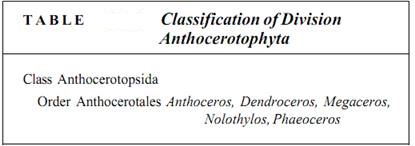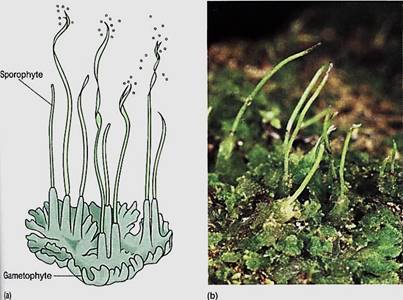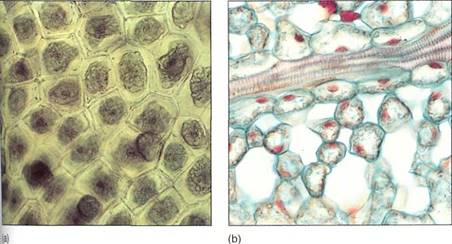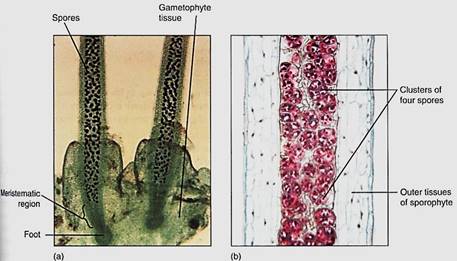


 النبات
النبات
 الحيوان
الحيوان
 الأحياء المجهرية
الأحياء المجهرية
 علم الأمراض
علم الأمراض
 التقانة الإحيائية
التقانة الإحيائية
 التقنية الحيوية المكروبية
التقنية الحيوية المكروبية
 التقنية الحياتية النانوية
التقنية الحياتية النانوية
 علم الأجنة
علم الأجنة
 الأحياء الجزيئي
الأحياء الجزيئي
 علم وظائف الأعضاء
علم وظائف الأعضاء
 الغدد
الغدد
 المضادات الحيوية
المضادات الحيوية|
Read More
Date: 15-11-2016
Date: 16-11-2016
Date: 16-11-2016
|
Division Anthocerotophyta: Hornworts
Hornworts are a group of small, inconspicuous thalloid plants that grow on moist soil, hidden by grasses and other herbs (Table ). They rarely inhabit tree trunks or bare rock, so one does not often encounter them unless one is looking for them specifically. Roadside cuts and stable eroded soil are good sites for hornworts. Hornworts number about 400 named species in five or six genera, with Anthoceros and Phaeoceros being common examples. Many of the species names are probably synonyms, that is, several names applied to the same species, because many hornworts have such variable growth forms that individuals of the same species can differ greatly under varied conditions.
Hornworts superficially resemble thalloid liverworts, the gametophores of many species being ribbon-shaped and thin, without a distinct stem or leaves (Fig. 1). However, hornworts never contain oil bodies, whereas liverworts almost always do. As in all other embryophytes, an alternation of heteromorphic generations occurs, with the sporophyte depending on the larger, photosynthetically active gametophyte. But hornworts are quite

distinct from all other embryophytes, including the other nonvascular plants. One of the most striking features is the presence of a single large chloroplast in each cell as opposed to the numerous small plastids present in all other non-algal plants (Fig. 2). The single chloroplast per cell is characteristic of many algae and is surprising in the hornworts. Furthermore, hornworst chloroplasts have a pyrenoid, an algal feature absent in all other embryophytes. Hornwort chloroplasts may be representative of the condition of the ancestors of all embryophytes, or they may indicate that hornworts had a separate algal origin, distinct from all other embryophytes. Unfortunately, we do not know what the chloroplasts of the earliest land plants were like because they are not preserved in any known fossil.

FIGURE 1: A) The "horns" of a hornwort are sporophytes that grow continuously from a basal meristem. The lower part of the sporophyte is surrounded by gametophyte tissue. (b) Anthoceros species. ((Robert and Linda Mitchell).

FIGURE 2 :(a) Hornwort cells are unique among embryophytes: Each has just one plastid. Outside of homwats, this feature is known only in algae. Although it may seem trivial, it must represent a significantly distinct cell/plastid relationship. The plastid's reproduction must be carefully coordinated with that of the cell, and a special mechanism is necessary to ensure that both progeny cells receive one each (X 60). (b) Cells of privet leaf with many chloroplasts each (X 60).
THE GAMETOPHYTE GENERATION
The protonema phase in hornworts is even more reduced than in liverworts. As few as three or four protonema cells are produced before the gametophore phase is established in most species. Gametophores are always thin, at least along the edges. Only in the center do they become more than four or five cells thick. They may be shaped like a ribbon or a heart, or they may grow outward irregularly, forming a disk. The upper surface in many species is smooth, but in others leaf-like lamellae grow upward. The gametophyte is parenchymatous, rather succulent but brittle. It does not tolerate drying; gametophores of hornworts typically live for less than 1 year in temperate climates. They act as winter annuals, appearing in the cool, moist autumn months, growing during winter, producing sporophytes in the spring, and dying before summer. In some species, they form oil-rich "tubers" as inner cells fill with oil and outer cells die; one thallus can produce several tubers.
Internally, hornwort gametophytes have numerous chambers. Young plants have mucilage chambers formed as cells break down and their contents are altered chemically into mucilage. With age, these dry out and become air chambers and are then invaded by Nostoc cyanobacteria. All hornworts form this symbiosis and presumably benefit by receiving nitrogen compounds from the Nostoc.
Gametangium development in hornworts is distinctive (Fig. 3). Unlike all other embryophytes, the antheridial initials of hornworts are not surface cells on the gameto- phyte. Instead, a special mucilage chamber forms near the upper surface; then cells lining the chamber grow into it and become antheridia. The chamber expands as the antheridia grow, and finally its roof breaks and only then are antheridia exposed to the environment.

FIGURE 3: (a and b) In mosses, the initial cell in the formation of either an antheridium or an archegonium lies on the surface of the gametophyte. Then cell divisions change this single cell into a mass that has sterile jacket cells and reproductive central cells. This pattern occurs in all mosses, liverworts, and vascular plants. The gametophytes of flowering plants are so reduced that the pattern is not obvious. It is discussed in Chapters 24 and 25. (c and d) The gametangia of hornworts are unique; the antheridia (c) do not form on the true surface of the gametophyte, and the egg (d) is not surrounded by discrete archegonial cells.
As sperm cells mature, the sterile outer cells of the antheridia transform their chloroplasts into chromoplasts, becoming orange or yellow.
Archegonia are formed from superficial cells, but the archegonia do not completely surround the egg as do the flask-shaped archegonia of other embryophytes. Rather, the egg lies below a short neck and neck canal but is surrounded by vegetative thallus cells. Even the neck cells are not particularly distinct but rather are difficult to distinguish from ordinary thallus parenchyma cells.
Once fertilization occurs, the zygote divides longitudinally; in mosses and liverworts, it divides transversely.
THE SPOROPHYTE GENERATION
Similarities between sporophytes of hornworts and those of mosses or liverworts are not easy to find. Hornworts have a foot embedded in gametophore tissue, but there is no seta or discrete sporangium (Figs. 4, and 5). Instead, just above the foot is a meristem that continuously produces new sporangium tissues. As the newly formed cells are pushed upward, they grow, differentiate, mature, and die. They are simultaneously being replaced by more cells from the basal meristem. Consequently, the sporangium is a long, hornlike cylinder, typically 1 or 2 cm long in Anthoceros and Phaeoceros, but up to 12 cm in some species. At the tip, the sporangium is mature and open as a result of dehiscence along two linear apertures. The outer layer of sterile cells is thick, up to six cells deep, and chlorophyllous. It has stomata in Anthoceros and Phaeoceros but lacks stomata in Notothylos, Dendroceros, and Megaceros. Unlike liverworts, hornworts have no nodules or bands on their cell walls. Spores are green, golden yellow, brown, or black and in some species are multicellular when ready to be released. Hornworts have a columella as in mosses, but unlike the elaters of liverworts, those of hornworts (often called pseudoelaters) are multi- cellular and do not have spirally thickened walls. The basal meristem is active over a long period, depending on moisture availability and temperature, and large numbers of spores can be produced by each sporophyte. Several attempts have been made to remove the

FIGURE 4: (a) The base of the sporophyte resembles a foot embedded in the gametophyte, and recently transfer cells have been discovered, so active nutrient transport into the sporophyte must be occurring. Just above the foot is a meristematic region. (b) At a higher level, equivalent to Figure 22.32c, spores are mature. (Robert and Linda Mitchell)

FIGURE 5:A longitudinal section through the sporophyte. At the base is a meristematic region (a); higher, above the basal meristem, sporocytes (spore mother cells) undergo meiosis (b). At higher levels the spores become mature (c) and are then released (d). This type of continuous meiosis is unknown in plants other than hornworts.
sporophyte surgically from the gametophyte and grow it in laboratory conditions, but even though it is chlorophyllous, it dies. It is not known if death is caused by a lack of minerals, insufficient photosynthesis, or absence of growth factors, vitamins, or hormones from the gametophyte.



|
|
|
|
التوتر والسرطان.. علماء يحذرون من "صلة خطيرة"
|
|
|
|
|
|
|
مرآة السيارة: مدى دقة عكسها للصورة الصحيحة
|
|
|
|
|
|
|
نحو شراكة وطنية متكاملة.. الأمين العام للعتبة الحسينية يبحث مع وكيل وزارة الخارجية آفاق التعاون المؤسسي
|
|
|